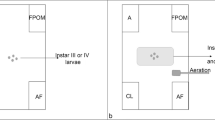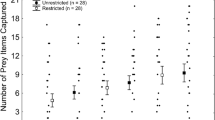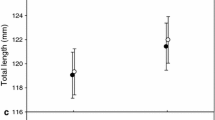Summary
In laboratory experiments, I studied differential susceptibility of four co-occurring species of chironomids to a predatory damselfly. The chironomids differed in foraging behavior and could be ranked according to the amount of time they spent outside of their tubes. In choice experiments, the predator consistently selected the prey which spent more time out of the tube, and time out of tube was a significant predictor of the predation rate coefficient. Electivity indices, calculated from field samples and diet analyses of the predator, supported the laboratory results. The data suggest that exposure to predators in a heterogeneous prey community is largely determined by tubedwelling behavior.
Similar content being viewed by others
References
Akre BG, Johnson DM (1979) Switching and sigmoid functional response curves by damselfly naiads with alternative prey available. J Anim Ecol 48:703–720
Benke AC (1978) Interactions among coexisting predators—A field experiment with dragonfly larvae. J Anim Ecol 47:335–350
Berg CO (1950) Biology of certain Chironomidae reared from Potamogeton. Ecol Monogr 20:84–99
Bohanan RE, Johnson DM (1983) Response of littoral invertebrate populations to a spring fish exclusion experiment. Freshwater Invert Biol 2:28–40
Chutter FM (1961) Certain aspects of the morphology and ecology of the nymphs of several species of Pseudagrion Selys (Odonata). Arch Hydrobiol 57:430–463
Crowder LB, Cooper WE (1982) Habitat structural complexity and the interaction between bluegills and their prey. Ecology 63:1802–1813
Crowley PH (1979) Behavior of Zygopteran nymphs in a simulated weed bed. Odonatologica 8:91–101
Dillon PM (1985) Chironomid larval size and case presence influence capture success achieved by dragonfly larvae. Fresh Invert Biol 4:22–29
Dodson SI (1975) Predation rates of zooplankton in arctic ponds. Limnol Oceanogr 20:426–433
Gilinsky E (1984) The role of fish predation and spatial heterogeneity in determining benthic community structure. Ecology 65:455–468
Hall DJ, Cooper WE, Werner EE (1970) An experimental approach to the production dynamics and community structure of freshwater animal communities. Limnol Oceanog 15:839–928
Hershey AE (1985) Experimental effects of predatory sculpin on the chironomid communities of two arctic litoral zone habitats. Ecology 66:1131–1138
Hershey AE (1986) Selective predation by Procladius in an arctic Alaskan lake. Can J Fish Aq Sci 43:2523–2528
Hershey AE, Dodson SI (1985) Selective predation by a sculpin and a stonefly on two chironomids in laboratory feeding trials. Hydrobiol 124:269–273
Hershey AE, Dodson SI (1987) Predator avoidance by Cricotopus: Cyclomorphosis and the importance of being big and hairy. Ecology (in press)
Johnson DM (1973) Predation by damselfly naiads on cladoceran populations: Fluctuating intensity. Ecology 54:251–268
Johnson DM, Crowley PH (1980) Odonate “hide and seek”: Habitat-specific rules? Pages 569–579 in W.C. Kerfoot, editor. The evolution and ecology of zooplankton communities. University Press of New England, Hanover, New Hampshire, USA
Johnson DM, Crowley PH, Bohanan RJ, Watson CN, Martin TH (1985) Competition among larval dragonflies: A field enclosure experiment. Ecology 66:119–128
Kormondy EJ, Gower JL (1965) Life history variations in an association of Odonata. Ecology 46:882–886
Lawton JH (1971) Maximum and actual field feeding-rates in larvae of the damselfly Pyrrhosoma numphula (Sulzer) (Odonata: Zygoptera). Freshwat Biol 1:99–111
Mackay RC, Wiggins GB (1979) Ecological diversity in Trichoptera. Ann Rev Entomol 24:185–208
Merrill RJ, Johnson DM (1984) Dietary niche overlap and mutual predation among coexisting larval Anisoptera. Odonatologica 13:387–406
Merritt RW, Cummins KW (1984) An introduction to the aquatic insects of North America, 2nd edition. Kendall/Hunt Publishing Co., Dubuque, Iowa. p 441
Oliver DR (1971) Life history of the Chironomidae. Ann Rev Ent 16:211–230
Peckarsky BL (1980) Predator-prey interactions between stoneflies and mayflies: behavioral observations. Ecology 61:932–943
Pritchard G (1964) The prey of dragonfly larvae (Odonata; Anisoptera) in ponds in Northern Alberta. Can J Zool 42:785–800
Pritchard G (1965) Prey capture by dragonfly larvae (Odonata: Anisoptera). Can J Zool 43:271–289
Shiozawa DK, Barnes JR (1977) The microdistribution and population trends of larval Tanypus stellatus Coquillett and Chironomus frommeri Atchley and Martin (Diptera: Chironomidae) in Utah Lake, Utah. Ecology 58:610–618
Steel RGD, Torrie JH (1980) Principles and Procedures of Statistics: A Biometrical Approach. McGraw-Hill Book Company, New York
Thomson DJ (1978) The natural prey of the larvae of the damselfly, Ischnura elegans (Odonata: Zygoptera). Freshwat Biol 8:377–384
Thorp JH, Bergey EA (1981a) Field experiments on interactions between vertebrate predators and larval midges (Diptera: Chironomidae) in the littoral zone of a reservoir. Oecologia (Berlin) 50:285–290
Thorp JH, Bergey EA (1981b) Field experiments on responses of a freshwater, benthic macroinvertebrate community to vertebrate predators. Ecology 62:365–375
Thorp JH, Cothran ML (1984) Regulation of freshwater community structure at multiple intensities of dragonfly predation. Ecology 65:1546–1555
Walde SJ, Davies RW (1984) Invertebrate predation and lotic prey communities: Evaluation of in situ enclosure/exclosure experiments. Ecology 65:1206–1213
Walshe BM (1947) Feeding mechanisms of Chironomus larvae. Nature 160:474
Walshe BM (1950) The function of haemoglobin in Chironomus plumosus under natural conditions. J Exp Biol 27:73–95
Walshe BM (1951) The feeding habits of certain chironomid larvae (subfamily Tendipedinae). Proc Zool Soc Lond 121:63–79
Werner EE, Gilliam JF, Hall DJ, Mittlebach GG (1983) An experimental test of the effects of predation risk on habitat use in fish. Ecology 64:1540–1548
Wiley MJ (1978) The biology of some Michigan trout stream chironomids (Diptera: Chironomidae). Michigan Academician 11:193–209
Wiley MJ (1981) Interacting influences of density and preference on the emigration rates of some lotic chironomid larvae (Diptera: Chironomidae). Ecology 62:426–438
Wiley MJ, Kohler SL (1984) Behavioral adaptations of aquatic insects. In: The Ecology of Aquatic Insects, Resh VH, Rosenberg DM (eds) Praeger Publishers, New York pp 101–133
Author information
Authors and Affiliations
Rights and permissions
About this article
Cite this article
Hershey, A.E. Tubes and foraging behavior in larval Chironomidae: implications for predator avoidance. Oecologia 73, 236–241 (1987). https://doi.org/10.1007/BF00377513
Received:
Issue Date:
DOI: https://doi.org/10.1007/BF00377513




